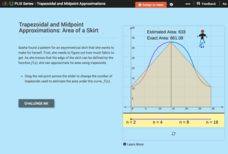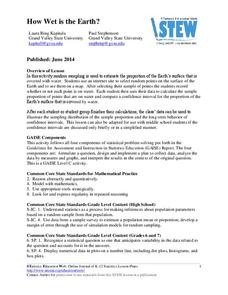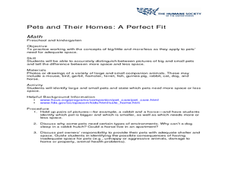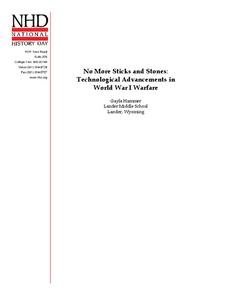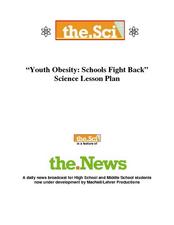Lions Clubs International Foundation
Mindful Self-Awareness Exercise: Accurate Self-Perception
When we look in a mirror, we often don't see ourselves as others see us. Our mirror may be clouded, cracked, or distorted by what we see as our weaknesses. The final exercise in the mindfulness series focuses on building a more accurate...
Curated OER
Moon Watch: Observing the Lunar Phases with a Model
How do you know the moon is going broke? It's down to its last quarter. The lesson provides a more accurate way to teach lunar phases, emphasizing not only naming or understanding them, but being able to explain why they occur....
CK-12 Foundation
Trapezoidal and Midpoint Approximations: Area of a Skirt
When are trapezoids better than rectangles? Using trapezoids pupils approximate the area of fabric defined by a function. Just like with rectangles, learners realize the more trapezoids the more accurate the approximation. Scholars use...
US National Archives
Eastern Europe 1939-45 — Ukraine
Was Joseph Stalin desperate or exaggerating the USSR's need for assistance on the Eastern Front in 1942? History students examine two differing opinions on Stalin's position and the reality of the Eastern Front just three years before...
PBS
The History and Use of Sampling Methods
Young mathematicians define population, draw convenience sample from the population, draw quota sample from the population, and draw random probability sample from the population. They explain why a random probability sample usually...
Curated OER
Maps Not Drawn to Scale
In this maps worksheet, students redraw a map to make it more accurate and drawn to scale in the space given. Students draw 1 map and answer 2 questions.
Nuffield Foundation
How Much Energy Is There in Food?
People associate calories with food, but what is a calorie? Young scientists measure the number of calories in samples of food to better understand the concept. They test a variety of samples, take measurements, and compare their results...
Curated OER
Evidence of Evolution by Natural Selection: Testable Hypotheses #2
These slides will activate prior knowledge with real-life examples of natural selection. The predictions and outcomes for those examples are explained. Your students will like the information about the relevant chromosome tests that can...
EngageNY
Sampling Variability in the Sample Mean (part 2)
Reduce variability for more accurate statistics. Through simulation, learners examine sample data and calculate a sample mean. They understand that increasing the number of samples creates results that are more representative of the...
Arcademics
Octopus Feed
A fast-paced multiplayer game challenges scholars to identify homophones. Once the timer starts, a player's octopus grabs the focus word's homophone pair with its tentacle. The faster and more accurate a participant is, the more points...
Education World
Thanksgiving, More Than a Thank You: A WebQuest for Grades 3-6
Here's a thought-provoking and engaging lesson for your charges. It's a Webquest about Thanksgiving. Groups of learners research Thanksgiving customs, history, and experiences. They are assigned the task of renaming Thanksgiving in order...
BioEd Online
Arm Model
Arm your young scientists with knowledge about anatomy as they build their own model of the elbow joint. Help them get a firm grasp on how muscles and bones interact to allow movement as they try different positions for the muscles on...
Statistics Education Web
How Wet is the Earth?
Water, water, everywhere? Each pupil first uses an Internet program to select 50 random points on Earth to determine the proportion of its surface covered with water. The class then combines data to determine a more accurate estimate.
Point Pleasant Beach School District
Parabola Project
Class members select a picture that contains a parabola and construct a drawing of it using function graphs in the quadratic project. Individuals restrict the domains of the functions to create a more accurate drawing. They then submit a...
Arcademics
Giraffe Karts
Take a ride in a go-kart in a fast-paced race. Giraffes speed along the track while scholars read subjects and choose the correct verb. The more accurate subject-verb agreements equal faster wheels.
Curated OER
How Accurate Is It?
Learners examine how generalizations can easily be invalid. They qualify generalizations to make them accurate and challenge generalizations made about people, insist on knowing the evidence that supports these, and modify their own...
Curated OER
Pets and their Homes
Students explore the space needed for an animal to live in. For this pets lesson, students view pictures of animals and decide which one needs more space or less space to live. Students discuss animals environments and why certain spaces...
Curated OER
More Tables Questions
In this multiplication worksheet, students answer 40 short answer questions relating to a table square. Students answer each question as fast and as accurately as they can.
National History Day
No More Sticks and Stones: Technological Advancements in World War I Warfare
Remind young historians that many technological advancements influenced the events of World War I. After analyzing technology's evolution through primary sources, discussing the changes over time, and watching various video clips,...
Curated OER
Youth Obesity: Schools Fight Back
Explore nutrition and healthy eating habits with a study on youth obesity. Learners watch a PBS documentary on the obesity epidemic which discusses government programs aimed at healthier choices, as well as more localized efforts. Kids...
Weather Bug
WeatherBug
Exploring the weather has never been more intriguing! Whether you are looking for a quick glance at the 10-day forecast, trying to figure out if lightning is heading your way, or wondering what the pollen count is, you will find out...
Kenan Fellows
Density
Most scholars associate density with floating, but how do scientists determine the exact density of an unknown liquid? The third activity in a seven-part series challenges scholars to find the mass and volume of two unknown liquids. Each...
Museum of Science
Virtual Heart
No more beating the pavement to find a virtual model of the human heart. See one in continual real-time motion, and layer it to highlight electrical impulses, blood flow, and valve activity.
Curated OER
Variance and Covariance: How much to do baseball players really make?
Is baseball really the road to riches? Here, statisticians look at salary data from baseball players and use variance to measure the spread of the data to more accurately answer that question. Note: The salary data provided is from 1994,...




